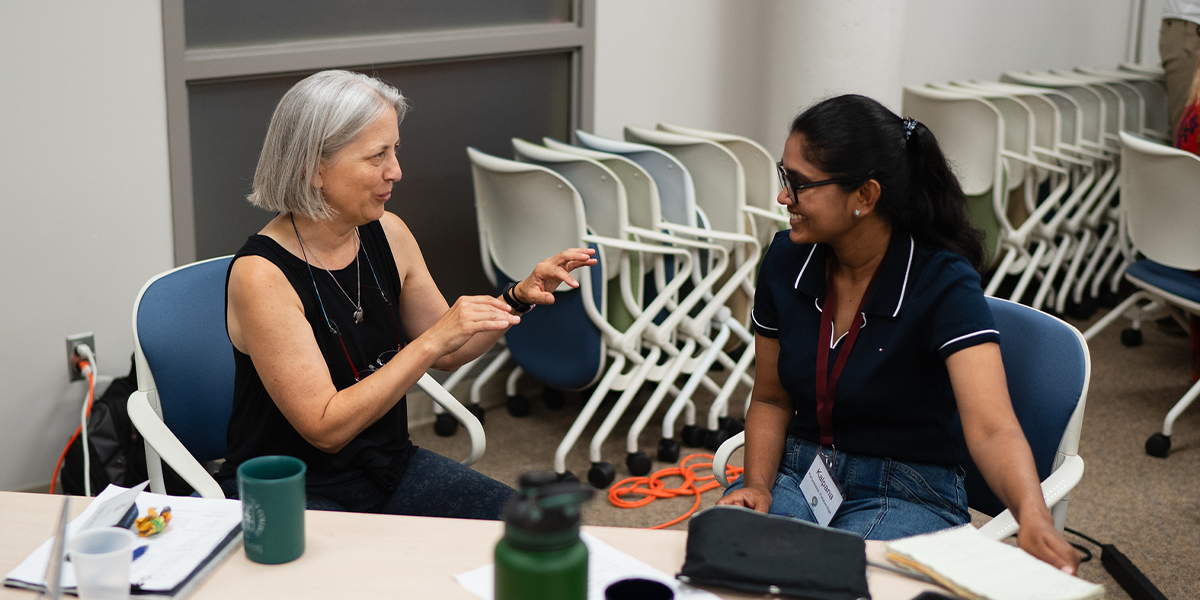
Elizabeth Borer with a collaborator at a DRAGNet meeting this summer on the University of Minnesota's St. Paul campus.
As an undergrad at Oberlin College in Ohio, Elizabeth Borer chose biology as her major the way many do: She liked science and was getting decent grades, so figured she’d hop on the premed track and become a doctor. Then, one semester, she signed up for a field botany class to pick up some fun credits alongside biochemistry and discovered her real passion: Plants.
This past summer, that passion, along with a similarly powerful penchant for making research more inclusive, found a rare reward. In June, Borer, now a professor of ecology, evolution and behavior, was bestowed a Regents professorship, the highest award the University of Minnesota gives to its faculty.
“It’s a deep honor,” Borer says. “The award feels like incredible recognition of my research contributions and my work to broaden the discipline. It feels really wonderful to have both of those recognized in this way.”
Annoyed into action
Borer’s unique path to success started, ironically, with frustration. As a graduate student, she found herself irritated that different questions were being asked in terrestrial, freshwater, and marine habitats, making it almost impossible to understand whether biodiversity was maintained the same way. As a postdoc and early faculty member, she became increasingly frustrated that experiments studying impacts such as grazing and fertilization on biodiversity and productivity tended to ignore the possibility for interactions among multiple variables. She began focusing her work on attempting to set the field right. “Getting mad can be really productive,” she says. “It led me to read more, and I started seeing the gaps.”
Along with being at odds with the conclusions other scientists were drawing about relationships between disturbances and ecosystem productivity, she and a few colleagues also found themselves irritated with the conventional approach to studying them. Each research group designed experiments in a unique way, making it hard to tell whether differences in results were due to real biological variation or simply methodological artifacts.
“During a workshop where we were synthesizing results across many studies, a few of us were sitting around drinking coffee and complaining about how all those scientists don’t do all their science the same way, and how annoying is that,” she recalls. “Then we thought, ‘We’re scientists. We should do this!’”
That “aha!” moment led Borer and colleagues nearly two decades ago to create a standardized protocol for studying nutrient-herbivore interaction effects on grasslands. Then they invited research teams from around the world to use it. Within a year, research teams at nearly 30 sites on four continents had committed to using this common protocol and sharing data.
And things only grew from there. Today, the collaboration, known as the Nutrient Network—NutNet for short—involves more than 300 researchers from more than 150 sites in 28 countries across every continent except Antarctica. To date, NutNet has yielded over 140 publications in peer-reviewed journals providing unprecedented insights into the complexities of grassland ecosystem productivity. It also recently spawned a second major initiative, DRAGNet, which adds in the impact of physical disturbance of soil and already has engaged researchers at 60 sites in 18 countries. Meanwhile, other research teams have noted the success of the distributed, collaborative approach and applied it to studies in such diverse areas as drought response, plant population dynamics, marine coastal biology, insect population dynamics, and more.
Product and process
As impactful as the research findings have been, just as significant—and perhaps even more rewarding for Borer—have been developing and successfully testing a new way of doing science. By creating and field-testing an innovative, but inexpensive, model for networked research, Borer and colleagues have made it possible for scientists around the world to contribute to a massive research project using a common protocol. That means the results are more robust and more generalizable than they would be with a more localized, less diverse base from which to draw data. It also means that scientists who lack extensive resources can contribute.
“We have created a new approach that has demonstrated to the discipline of ecology that we can build long-term, large-scale data sets to understand global change at scale, and we can also build capacity. We can collaboratively advance knowledge about global change. And that’s exciting to me.”
Borer is quick to point out the important role the University has played in her success, by supporting a novel approach to research, providing excellent opportunities for students, and maintaining invaluable facilities such as the Cedar Creek Ecosystem Science Reserve to do her work. Now, the resources made available by the professorship will allow her to build knowledge and capacity using NutNet and DRAGNet by providing dedicated support for an annual in-person meeting of collaborators.
“It ensures the capacity of my research program to keep these global networks going. It will allow me to bring people to the U to continue to broaden participation, to foster careers of people who are earlier career scientists, scientists from around the world with great ideas who might not have had the same opportunity to be at the table. And that’s exciting to me,” she says.
What’s next? Not surprisingly for an ambitious person like Borer, operating on only six continents doesn’t sit well.
“I'm working with a guy who thinks he might be able to use our protocols to sample emerging grasslands in Antarctica,” she reports. “But TBD.” –Mary Hoff
The role of nutrients in grassland plant diversity and biomass
- Where grazing by native herbivores increases the amount of sunlight reaching the ground, it also increases plant diversity, often promoting native plants.
- When nutrients are added, grassland plant diversity declines.
- Grassland biomass is primarily controlled by herbivores at low precipitation sites but by nutrients at high precipitation sites.
- Nutrients usually—but not always—increase grassland plant biomass. Surprisingly, at 25% of sites nutrients have no effect.